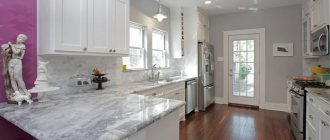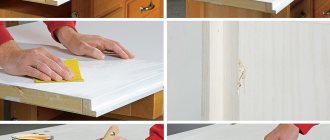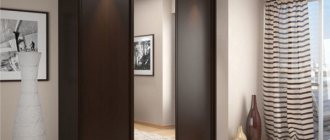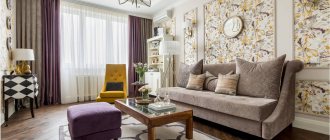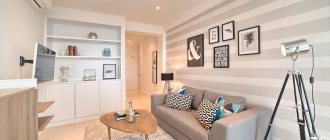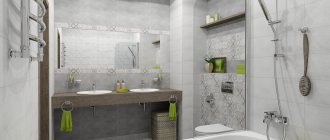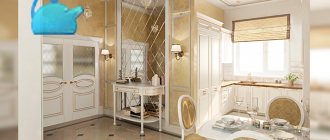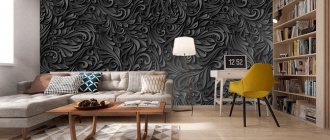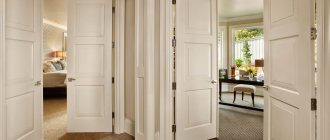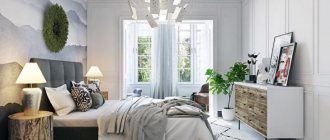What is his mystery? Who knows!
Maybe the reason lies in the fact that we are talking about the ancestor of all modern carpets, and therefore the standard of beauty in carpet art.
Perhaps it’s all about the complex ethnic patterns that you can look at for hours and not feel tired. But it is clear that an oriental rug always has a chance to become the highlight of your home. And if you have already racked your brains over which carpet to choose, then you can safely take the oriental one - you definitely won’t go wrong. You just need to take a closer look at it, decide on the color and, perhaps, add a couple of fresh details to the interior in addition to it.
Is it possible to use such carpets in modern design?
Many people still have an old carpet collecting dust in their dacha or utility room that can still be used.
In a modern interior, wall decor can be used as a floor carpet
For modern stylistic trends, this decorative element is inappropriate. But if you are suddenly thinking of changing the style of your house or apartment, then the retro carpet is applicable in the following stylistic directions:
- country;
- vintage.
You can hang a rug with animals in the hunting lodge. There he will be in place.
Use in a children's room is also possible. Children will be delighted by the beautiful drawings of bears, tigers, deer and other types of animals.
Country and vintage are trends in the classical stylistic direction. But the use of wall paintings of deer can also be found in other trends - ethnic ones.
Deer is a mammal that is found in the vast north and is found in Scandinavia. Therefore, it will be very useful for the Scandinavian ethnic style. We cannot call this style classic; it is still an innovation of recent years.
To decorate rooms in the Scandinavian style, a carpet with blue and blue patterns is suitable. green, white. These shades echo the elements of nature and the ethnic group of Scandinavia: green endless pine forests and bright blue lakes and seas in snow-white spaces under a blue sky.
The rustic style is characterized by the use of animal skin carpets on the floor, a large amount of stone coverings and wood. A covering with animal patterns will also fit into the interior of such a room.
Where are oriental rugs made?
At first glance, the question is devoid of logic. Where are oriental rugs made? Of course, in the East. The birthplace of Persian carpets, which have become a legend, is Iran. Nepal, India, and Tibet have long been famous for their products. As an example, we can cite a number of other geographical names, but that is not the point.
For a long time is the key word here. Today there are many European companies producing carpets in a delightful oriental style. Can these carpets really be called oriental? Let's figure it out.
In order for the carpet to turn out to be of decent quality, it is not enough to take high-quality materials and a suitable pattern. The skill of the person who makes it also matters. And it is very desirable that this skill be inherited from ancestors and passed on as a family heirloom. As in any art, continuity is important in carpet weaving.
Oriental luxury in your interior: choosing luxurious handmade Persian carpets
Our Design Museum today has a great theme - Persian carpets. They are considered the most elite among traditional ones. And the point is not that the products are very expensive, but that every real carpet is always created by hand, according to strict traditions that go back more than one millennium.
This in itself is a great piece of home decor! After all, each of them is always unique; you will never find two identical products. We can safely say that the combination of original patterns, soft pile and bright colors creates a masterpiece every time.
There is an old belief: fairy genies live in Persian carpets, as well as in lamps. And in many oriental fairy tales, flying carpets are mentioned.
If you want to buy a real Persian product, then we will give some tips.
1. In order not to run into a fake, it is best to buy such an item in a special store.
2. Check with the seller what the product is made of. The originals are woven from wool and silk, sometimes with cotton threads woven into their base.
3. It is always handmade and only handmade!!! They are woven using the knot weaving method.
4. Specify the country of origin. If this is Uzbekistan, Afghanistan, Iran, Iraq or Pakistan, then most likely this is a real thing and not a fake.
5. Like a real work of art, a Persian carpet cannot be cheap. And over the years, its value only increases. Therefore, when buying such an item, you can be sure that not only will it not fall in price, but, on the contrary, it will cost much more.
It is not for nothing that in ancient times only Arab sheikhs and sultans could afford them.
6. It is very thin and soft to the touch, but at the same time dense and warm, thanks to the thick pile. Its uses are varied: it can be laid on the floor or hung on the wall, used as a painting or decoration due to its bright, unique pattern.
7. It is advisable to ask the seller in what tradition the product was made. There are only a few dozen of them. And each is still used only in one area and nowhere else.
And each territory is characterized by its own specific strictly consistent patterns and weaving techniques, which creates the individual style of a particular region.
When buying a product, you should focus, first of all, on the overall color scheme of the entire interior. But, nevertheless, in Eastern philosophy certain characteristics of flowers have developed.
For example, blue and light blue represent wisdom, calmness and serenity. Shades of red and orange represent health, confidence and strength.
Gold and yellow colors denote status and divine manifestation. And turquoise and green are a symbol of energy, youth and bloom.
With the help of such beauty you can create an exquisite interior that will always please the eye!
However, a carpet created by a hereditary weaver also has its drawbacks:
- First of all
, he will be alone. Or two. In any case, these carpets will be unique. - Secondly
, the cost of such a product will be fabulous. Why? The answer lies in the previous paragraph: a single product is always very, incredibly and obscenely expensive.
Modern carpet manufacturers, who do not have a string of great-grandfathers weaving carpets behind them, have found a way out of the situation. They established modern production, dividing responsibilities between participants in the work process. In other words, the first part (design development, material selection) is carried out in Europe - Germany, France, Italy, etc. The second part is transferred to those same eastern states, where experienced craftsmen create masterpieces of oriental carpet weaving using machine, hand or machine-hand methods.
If you look at the product descriptions on our website, you will see the names of two or more countries listed under the headings “country of brand” and “country of origin”. This tactic makes it possible to produce carpets in larger quantities than just one every couple of months. At the same time, the products retain their originality, since they were actually produced in the East, where they know a lot about carpet art.
Carpet in the interior: 7 selection criteria
It’s a well-known fact: even the most stylish room has an unfinished look without a carpet and looks empty, bringing to mind a public place or a museum. Designers advise approaching the selection of a product with all possible seriousness. To make the purchase successful, you need to take into account the interior design and traffic in the room, as well as pay attention to the parameters of the carpet.
On the issue of zoning Source apartmenttherapy.com
Purpose
In fact, carpets in the interior serve one of two functions. An accent carpet attracts attention and enlivens the interior, while a background carpet merges with the interior, dims its brightness and creates coziness. Additionally, both options zone, insulate and soundproof the space.
Carpet accent Source topdom.ru
Material
The composition determines the service life, appearance and cost of the carpet product; It is customary to distinguish models made from natural, artificial or mixed fiber. The following varieties can be found on sale:
- Woolen. High-quality products with a long service life (up to 30-40 years for an industrial carpet and longer for a handmade model). They are dense and wear-resistant, retain heat well, but are expensive and require careful care. Some types of wool fade in the sun and cause allergies.
Wool carpet in a modern interior Source www.love-rugs.com
- Silk. Spectacular, with a shiny surface and exquisite pattern, they retain their shape and color for a long time. Handmade products painted with durable natural dyes are especially valued. A silk product will be a worthy decoration for any interior.
Made from silk Source m-strana.ru
- Made from viscose. The glossy texture and softness are reminiscent of silk models - just as bright, but more affordable.
Model made of viscose in a modern style Source samad.com
- Made from natural materials. These are products made from bamboo fibers, as well as jute and sisal, pleasant to the touch and practical to use.
The most popular option is carpets with a mixed composition (20-30% synthetics). Their advantage is increased wear resistance and affordable cost. Synthetic products include products made from propylene, nylon, nylon, and polyester. This type of coating is the most inexpensive, easy to clean, but also short-lived. Among synthetics, acrylic carpets stand out as completely hypoallergenic and practically indistinguishable from wool.
Eco-style woven jute rug Source www.salvabrani.com
Characteristics
The main characteristics are the length of the pile and density. The length (height) of the pile determines the softness and appearance; The difficulty of care and resistance to creasing depends on it. There are three categories based on pile height:
- Short pile (thread length up to 5 mm). The most practical and easy-to-maintain products. This makes them indispensable elements in the decoration of the living room, hallway and other places with heavy traffic.
- Medium pile (7-10 mm). Durable, warm, easy to clean. The best choice for use in a medium-load room.
- Long-pile (up to 10 cm). Furry models are the most comfortable and beautiful, children adore them. Most often they are purchased for a children's room or bedroom.
Carpet density is the number of knots (lints) per unit area; The average density (sufficient for a home product) is 200-300 knots per square meter. The products also differ in the way the surface is formed. The pile can form a loop surface (when the piles are not cut), velor, frieze, and combinations thereof.
Pile catlup (with different heights) Source www.homedynamix.com
Position
The carpet is chosen taking into account not only the interior features, but also the purpose of the room, as well as the lifestyle of the owners. In this case, they are guided exclusively by common sense:
- Carpets in the interior are a good way to zone a space and combine several design elements together.
- Gone are the days when the entire room was covered with carpet, right up to the walls, from baseboard to baseboard. This method visually narrows the space, so it’s not suitable.
An example of successful zoning Source happymodern.ru
- A snow-white model with long pile will be an excellent choice for the bedside area in the bedroom, but extremely unfortunate for the room of active offspring who love to tinker with the dog.
- In a modern bedroom interior, the use of bedside products is considered not the best choice. Two rugs break up the space and are reminiscent of the design preferences of the late 80s.
- The carpet in the living room should match the size of the upholstered area. Even an exclusive designer, but small rug will be lost against the backdrop of massive upholstered furniture.
Standard solution Source m-strana.ru
See also: Turnkey country house construction service
Size and shape
To understand what size carpet will ideally fit into a particular room, you will need to “try it on”. You can experiment with old newspapers by laying them out at the site of your future purchase. It is useful to take into account some subtleties:
- The shape of the product affects the shape of the room. A round rug in an elongated room will clearly be out of place.
- You cannot skimp on the size of the carpet for the soft area; it should partially (or better yet completely) go under the upholstered furniture.
Round does not mean boring Source m-strana.ru
- The carpet for the dining room is chosen so that its edge extends beyond the perimeter of the table by at least 70 cm. This way you can freely move the chairs away without fear of ruining the edge.
- For zoning, choose a model that is sufficient to fully accommodate a group of furniture (for example, a cozy chair with a floor lamp or a seating area).
- Carpets of odd shapes (other than rectangular, square or round) rarely fit into a modern interior.
- Small fashionable rugs can be used as an accent in combination with a larger piece. The idea will be especially successful in a spacious living room or library.
White faux leather rug Source m-strana.ru
What styles go with oriental rugs?
So, having understood the features of oriental carpets and made sure that this is a truly high-quality certified product, you can think about purchasing. Will the carpet suit your interior if the renovation has already been done and changing the design of the room is a troublesome task? An oriental rug will definitely be at home in your home if the interior is decorated in the following styles:
- Modern.
A style that is found most often today, both in its pure form and in all sorts of combinations with other trends. In any case, an oriental rug will be appropriate here, even (even more so!) if it becomes the only bright spot in the room. - Classical.
A classic is just that: a classic. The carpet, whose style gave rise to all other areas of carpet weaving, will look great against the backdrop of twisted decor and gilding. - Loft.
Yes, yes, unpainted wood, brick and oriental ornaments combine perfectly. - Country.
Oh, this comfort and rustic warm atmosphere! A colorful oriental rug belongs here. - Scandinavian and contemporary
as its derivative. A fluffy and cozy rug will definitely add warmth to the restrained color palette that dominates the room.
An oriental rug can actually be combined with any other style if you choose the right tactics. And it's not that difficult to do. To begin with, you can simply consult with the consultant of the store where you decided to purchase the carpet. You will be surprised, but people who deal with carpets every day can give you a lot of good advice on choosing them and introducing them into the interior.
Carpet on the wall in a modern interior
The carpet should suit the style of the room in which it will be located. It is desirable that it be harmoniously combined with other things and furniture. Its color scheme should match the design of the room. Let's figure out how carpets are selected for interiors decorated in different styles.
Classic
Carpets of restrained natural shades suit a classic interior. Choose products with ornaments, as well as tapestries with landscapes and subject compositions. These products will add coziness to the room and make the atmosphere even more luxurious.
Tapestry in a classic interior is the central element of the composition Source smartkilim.com
On the floor, on the wall...
Speaking about the oriental carpet, do not forget that it will be appropriate not only on the floor, but also on the wall. Traditionally, oriental homes are usually decorated with carpets located in all planes - both horizontal and vertical. That is why an oriental style carpet will not look ridiculous if you place it on the wall.
And don’t be embarrassed by the thought of sore Soviet apartments, where each wall had a carpet, and the wealthiest citizens even had two, both from ceiling to floor. To avoid this effect, just follow a few simple rules.
Firstly
, the carpet must be the right size. Options from wall to wall, and even those rolled up at the edges, as if “for growth”, are not accepted. A hanging rug should be at least smaller in size than one lying on the floor.
Secondly
, the carpet on the wall should please the eye, and not just serve as insulation. In our case, when it comes to oriental carpets, there are no problems here.
Third
, nothing should compete with the carpet hanging on the wall - neither paintings, nor photographs, nor colorful wallpaper. Just a plain wall and carpet - and you've hit the bull's eye.
In a word, an oriental carpet in the interior is a kind of universal remedy that makes a home cozy, stylish and unlike others.
Return to list
Latest trends in oriental rugs
The latest trends in oriental rug designs have proven that they are more popular than ever.
Design trends come and go, they are constantly changing and evolving. Sometimes they make us reconsider our past decorating choices or inspire us to make exciting new decisions.
Today, both fashion and interior design amaze with a variety of styles and emphasize deep colors filled with life and energy. Therefore, more and more people are learning about oriental carpets and admiring their beauty. After all, a handmade Oriental rug is an investment that will last for generations and has the potential to become a family heirloom.
An oriental carpet will be appropriate in any interior - both modern and classic. Have no doubt, a properly selected carpet will make your interior better!
Here are some of the leading trends in carpet weaving in recent years:
Open and bright colors
If this trend suits your daring nature, you'll find many stunning oriental rugs to suit your decor. The most common colors in the palette are terracotta, coral, turquoise and cobalt blue. If such colors seem too provocative and make you nervous, don’t worry: carpets with laconic geometric patterns are also in trend. Most often they are designed in calm colors and therefore are perfect for modern interiors. They help create a feeling of serenity. In these rugs you can find soft pastel colors and sophisticated shades of gray. These color schemes are the perfect way to bring a natural feel to your home.
Another significant trend is texture
High pile carpets add extra texture to a room. High-pile carpet is also good for high-traffic interior areas. These carpets provide a feeling of incredible comfort, softness and lightness underfoot that sensitive people will appreciate. In addition, on high-pile carpets, minor stains simply will not be noticeable.
Flat woven kilims are very popular this year
They are most often hand woven, most from Persian highland wool or natural silk. Most often, kilims are decorated with geometric patterns. Kilims can be used as blankets: for example, thrown over the arm of a chair or sofa. These rugs have no lining, so they can be used in different ways for decoration.
Re-dyed carpets
Perhaps one of the most popular trends in recent years. Initially, these carpets were invented to imitate vintage carpets. Such carpets are created by lightening an oriental carpet and then dyeing it again with natural dyes of plant origin. These rugs look very attractive as the original design is still legible even after a fresh dye job. There are a huge variety of flowers. It's a great mix of old and new, a great choice for environmentalists.
Among the redyed carpets, patchwork style carpets stand out especially
To create these rugs, vintage rugs are first cut into pieces and then sewn together to create a new rug. Usually the fragments are sewn together with large hand stitches. These carpets look like new after the redying process.
Oriental rugs are a trend that will never go out of style. Styles may change over time, but the basic idea and beauty of this art will remain with us forever.
